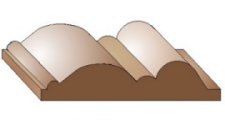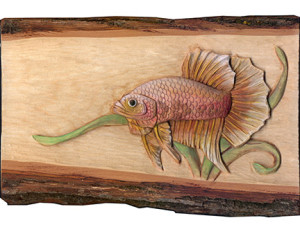Low Relief Carving
By L. S. Irish

Most of the carving example that we have from the early Egyptian and Greek artists are done in a style called Low Relief. In this technique the edges of one carved area slants down to the next intersecting level. The joint between the two areas can easily be seen. Low Relief is a carving that is done in definable layers and the entire carved surface has a shallow look to it. Low Relief is not necessarily carving that is done to a very small depth into the wood surface, it refers to the visual impression that the carving creates. In the image below you can see that the carved edges meet where they can be seen and no area casts a definite shadow onto the next to imply deep carving.
By using the Low Relief technique, your pattern is anchored to the wood background by the visible intersections, this emphasizes the impression that the design has been cut into the carving block.

After the pattern or design has been traced to your wood blank, with the use of the stop cut the background is removed. Work with either the c-curved gouges or with the skew to “hog out” the excess wood. When you have established the background level begin to smooth this area by taking shallower gouge cuts. The background does not need to be absolutely pristine at this time.
Individual areas within the design are now carved. Again use the stop cut to define the intersection to each area, then shave away or round over the area on which you are working to create a dimensional look. With most areas in your pattern the rounding over will begin with a high point in the center of this area then taper down in all directions to the adjacent parts of the design.
Although this type of carving has a shallow effect, work to establish different levels within your work. Leaves of a floral design that are tucked under the flowers petals should appear to be lower in the work than the flower, yet lay on top of the background. Low Relief often has an abundance of fine detail, this can be cut using either the v-gouge or a veiner.
 Once the basic levels have been created and each area rounded over and detailed, you will want to begin smoothing the work to it’s final finish. Low Relief designs can be very exciting, great dimension and detail can be created with in a depth of only 3/4 inches or less.
Once the basic levels have been created and each area rounded over and detailed, you will want to begin smoothing the work to it’s final finish. Low Relief designs can be very exciting, great dimension and detail can be created with in a depth of only 3/4 inches or less.
The Beta Fish pattern and full step-by-step instructions are available in Relief Carving Workshop, Techniques, Projects & Patterns for the Beginner by L. S. Irish.


Pingback: Relief Carving – Carving Digest